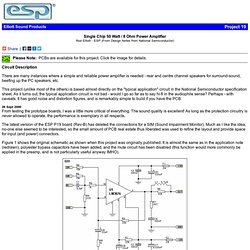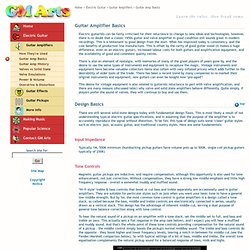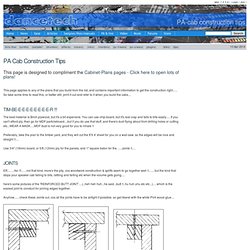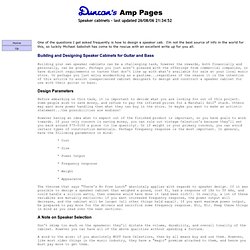

Dimarzio. Products. Suhr Guitars and Amps. DiMarzio.com. Single Chip 50W Stereo Amplifier. Single Chip 50 Watt / 8 Ohm Power AmplifierRod Elliott - ESP (From Design Notes from National Semiconductor) Please Note: PCBs are available for this project.

Click the image for details. Circuit Description There are many instances where a simple and reliable power amplifier is needed - rear and centre channel speakers for surround-sound, beefing up the PC speakers, etc. This project (unlike most of the others) is based almost directly on the "typical application" circuit in the National Semiconductor specification sheet. 26 Sept 2000From testing the prototype boards, I was a little more critical of everything. The latest version of the ESP P19 board (Rev-B) has deleted the connections for a SIM (Sound Impairment Monitor).
Figure 1 shows the original schematic as shown when this project was originally published. Figure 1 - LM3876T Power Amplifier Circuit Diagram (Original Version) Figure 2 - Revision-B Power Amplifier Circuit Diagram. 100W Guitar Amplifier (Mk II) 100W Guitar Amplifier Mk IIRod Elliott (ESP) New Version Created 27 Jan 2002 Updated 11 Jan 2008 Please Note: PCBs are available for for both power amp and preamp. Click the image for details. Introduction Guitar amplifiers are always an interesting challenge.
The tone controls, gain and overload characteristics are very individual, and the ideal combination varies from one guitarist to the next, and from one guitar to the next. One major difference from any "store bought" amplifier is that if you build it yourself, you can modify things to suit your own needs. The amp is rated at 100W into a 4 Ohms load, as this is typical of a "combo" type amp with two 8 Ohm speakers in parallel. Www.tcaas.btinternet.co.uk/jlh1996.pdf. GM Arts - Guitar Amplifiers. Electric guitarists can be fairly criticised for their reluctance to change to new ideas and technologies, however, there is no doubt that a classic 1950s guitar and valve amplifier in good condition still sounds great in modern recordings.

This is a testament to good design from the start. What has improved today is consistency, and the cost benefits of production line manufacture. This is offset by the rarity of good guitar wood (it makes a huge difference, even on an electric guitar), increased labour costs for both guitars and amplification equipment, and the availability of good and consistent quality valves. There is also an element of nostalgia, with memories of many of the great players of years gone by, and the desire to use the same types of instruments and equipment to recapture the magic.
Vintage instruments and equipment have become valuable collectors items also (often with very inflated prices) which adds further to the desirability of older tools of the trade. The Class-A Amplifier Site. The Cooperative Tube Guitar Amp Project. Speaker cab construction plans - construction tips. This page is designed to compliment the Cabinet-Plans pages - Click here to open lots of plans!

This page applies to any of the plans that you build from the list, and contains important information to get the construction right...... So take some time to read this, or better still, print it out and refer to it when you build the cabs.... The best material is Birch plywood, but it's a bit expensive. You can use chip-board, but it's real crap and falls to bits easily..... If you can't afford ply, then go for MDF particleboard....but if you do use that stuff, and there's dust flying about from drilling holes or cutting etc...WEAR A MASK.....MDF dust is not very good for you to inhale !! Speaker cabinets. One of the questions I get asked frequently is how to design a speaker cab.

I'm not the best source of info in the world for this, so luckily Michael Sabolish has come to the rescue with an excellent write up for you all. Building and Designing Speaker Cabinets for Guitar and Bass Building your own speaker cabinets can be a challenging task, however the rewards, both financially and personally, can be great. Perhaps you just aren't pleased with the offerings from commercial companies, or have distinct requirements or tastes that don't line up with what's available for sale at your local music store. Or perhaps you just enjoy woodworking as a pastime...regardless of the reason it is the intention of this article to assist inexperienced cabinet designers to design and construct a speaker cabinet for use with their guitar or bass.
Design Parameters Before embarking on this task, it is important to decide what you are looking for out of this project. A Note on Speaker Selection Bass Cabinets. How to Layout and Build a Guitar Amplifier Chassis : GuitarKitBuilder. In this article we cover how to lay out and build the chassis for a vacuum tube guitar amplifier.

While this article is intended primarily for the “homebrew” builder, it will also be useful background for the kit builder. With a few essential tools and proper procedures, you’ll find that building a vacuum tube guitar amplifier on a metal chassis to be a relatively simple matter. If you’re familiar with woodworking you are likely to know the adage “measure twice, cut once.” Similarly, much trouble and energy will be saved by spending sufficient time in planning the chassis job. Tube Amps, Kits, Pickups, Tubes, Parts, Books, Fender, Marshall, Online Music Store. Www.duncanamps.com/pdf/blues112.pdf.